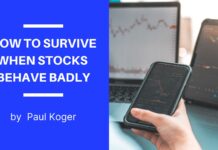Table of Contents
Almost 90% of traders lose money or that only a few professional traders can make a living. You’ve probably heard of this already, but let me tell you why.
When a buying frenzy takes hold in the stock market, it’s not easy to see the price movement for what it truly is: something that will pass.
But at that moment, many traders (often, inexperienced traders) simply see that other people are buying so they think that if they buy now, other traders will also buy after them; that they can sell it for profit. It’s a speculative purchase if you ask me.
As more people are stepping in to buy, it pushes the actual price up and it creates an uptrend that’s further pushing the stock price up. “Everyone is buying, they surely can’t be wrong,” they think. Eventually, it reaches a point when there are no more traders willing to buy because they think the price is already too high.
So, the situation is now different: there will be more people willing to sell than buy. The market is unlikely to reverse, yet almost everyone is just on one side.
That, my friend, is when mass losses happen. However, day trading can also be very rewarding if you adopt a profitable strategy (not a get-rich-quick scheme).
Breaking Away from the Herd
How then do you break from the herd and make above-average returns? That is what this article is all about. I’ve broken this guide on how you can be a successful day trader based on my personal experience and some tips from other successful traders to shorten the learning process.
Make or Adapt a Trading Strategy
Let’s begin by creating or adapting a strategy that you are comfortable with; something that fits your trading personality.
What Day Trading Is
Know that day trading is all about buying and selling a financial instrument, such as a stock, in the same trading day or multiple day trades in a single day. The idea is to carry that position overnight and remove negative price gaps and unmanageable risks between today’s close and tomorrow’s price at the open.
It is the Securities and Exchange Commission that regulates pattern day trading in the United States and it makes sure that brokers treat their traders fairly.
There are two distinct trading strategies that you can adopt to be a successful day trader: systematic and discretionary.
Systematic vs. Discretionary Trading Strategies
A systematic strategy is, just as the name suggests, where you use a systematic approach. A signal is created to start your position and another to exit your position. You do not use discretion, but risk management is handled by a system that you are using.
On the other hand, a discretionary strategy is where you make your trading decisions based on factors, which you believe are significant in generating a successful trade.
Find a Mentor Before You Day Trade

A trading mentor can boost your day trading know-how. Even if trading is not easy especially for new traders, (well, markets change all the time) a professional day trader is someone who can walk you through the process of understanding the market better.
These experienced traders have their own rules that they follow and they may even be willing to share their day trading strategies. If that’s the case, you can improve your skill as you watch them.
In finding a day trading mentor, consider their successful and transparent track record in day trading.
Do they have a trading platform/ trading platforms with enough content to help you understand the day trading strategy they use? Does their day trading strategy suit your goals and personality as well? How do they apply market research so they can generate audience insights?
For instance, if you want to focus on a swing trade, then choose successful swing traders. Be that trade options, day trade, and other trading strategies, some successful and experienced day traders that I can recommend are:
-
- Nathan Michaud (is a successful trader who created InvestorsLive.com and founded the Investors Underground)
- Timothy Sykes (co-founded Profit.ly, a stock trade community, and is a Penny stock advocate)
- Tim Grittani (compiled a DVD course on how he was able to turn $1500 of his personal savings into $2.7 million in only three years)
- Paul Scolardi (founder and CEO of Super Trades LLC); and
- Michele Koenig (another successful trader who specializes in day trading and swing trading. She is also the woman behind the Trade On The Fly DVD educational resources.)
To know more about them, you may also want to check out my review of successful day traders that teach their strategies.
Develop Trading Discipline
To be a successful day trader, you should not focus on finding the right strategy. It’s also about developing certain traits that will allow you to implement your chosen strategy in an effective way.
A key trait you should develop is discipline. Why? It’s because it will give you infinite opportunities to day trade and lessen the risk of losing money for the long term.
The actual trading time is only minuscule each day. For most of the time, you are just sitting, observing, and waiting for trade signals. However, it is in these same moments that requires discipline. The moment you see a trade signal, you also have to act fast and without hesitation to follow your trade plan.
Analyze Your Trading Results and Refine Them
Day trading is a career of metrics or statistics and you may either have statistics that generate losses or returns. Successful day traders, of course, have positive trading metrics.
And to be successful in this career, you need to review your profit loss ratio to know your potential to be profitable as a day trader. The best day traders I know have meticulous trading journals or records because they know they can data mine the journal to better understand what they can improve in their trading.
Keep a Day Trading Journal
Making money trading stocks will be easier if you keep a day trading journal. Believe me, this is going to be one of the most high-leveraged and impactful activities you can adopt as you can check your past performance.
As day traders, just make sure to include the tracking date, stock symbol, whether you sold short or bought long, the number of shares you bought, why you chose that number, what system (or trading software) triggered the entry signal, the percentage of gain or loss during the trading day, and whether there were economic announcements or report made during the time of the trade.
Avoid Risk of Ruin
Another important rule for aspiring day traders to adopt is to only risk what they can afford to lose. Since you will be trading at your own risk, it is best to consider your risk tolerance before buying and selling securities.
Some successful traders use a stop loss or stop-loss order. A day trading stop loss is knowing how much money you allow yourself to lose on the same trade day before you call it quits for that same day.
On the other hand, a stop-loss order is an order you place as a day trader with your online broker to buy or sell a security when it reaches a particular price. This well-thought-out strategy is meant to limit your loss as a day trader.
Bankroll Management
Bankroll management plays a pivotal role in all your decisions as an aspiring day trader. It is all about having a well-drawn-out day trading plan to target a certain end.
Manage the size of your positions as a day trader. Then, determine the size of your beginning capital in the stock market. How much are you planning to withdraw after you experience a good series of wins as a day trader?
Overall, the core of bankroll management is to help you as a day trader maximize the return of your capital while protecting it by avoiding a losing trade.
But what if you trade with a partner? You may take note of this rule: partners process data or follow certain procedures and rules.
Sticking to the 1% Risk Rule
Another rule I apply in day trading, which I hope novice day traders (even a pattern day trader) will also follow is to trade only to 1% of their overall bankroll.
Or better yet, don’t risk more than 1% of your account value on a single trade. Since no one wins in every single trade, the 1% risk rule protects your day trading capital from significantly declining in unfavorable situations.
As you become a day trader and follow this rule, there’s a high chance to make it successfully in your first trading year because you avoid making losing trades.
Can I Become A Successful Day Trader? Well, It’s All About Consistency!

In the trading world, consistency (how repeatable your action is) should be the number one goal for all day traders. What do I mean by this? You can begin by earning $100 a day in the first week, and then increase it to $200 a day in the second week.
You don’t want to make $100 on a Monday, another $100 on a Tuesday, lose $500 on Wednesday, lose $200 on a Thursday, and make $100 on Friday.
Once you achieve consistent results like an experienced day trader, there’s a higher chance you eventually earn real money on a consistent basis.
My hope is that you make winning trades starting today!









![Etoro Review – My Honest Opinion [+TUTORIALS]](https://foxytrades.com/wp-content/uploads/2018/03/Etoro-Review-100x70.jpg)
